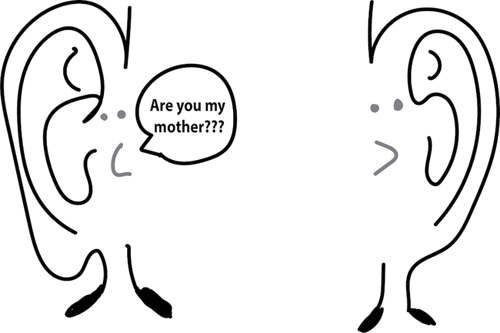
How is it possible that my earlobes are free when both my parents’ are attached?
April 22, 2022

- Related Topics:
- Classical genetics,
- Genetic myths,
- Complex traits,
- Common questions,
- Editor's choice
A graduate student from Belgium asks:
“My earlobes are not attached, but my parents' earlobes are attached. How is that possible? I read that the genetics are complicated, but the internet only says it's not possible. I'm worried.”
Fear not! Having unattached earlobes while your parents’ are attached is nothing to have an inheritance crisis over. And it’s actually more common than you think. Like you said, genetics really is complicated! While there are examples, especially on the internet, of hard and fast rules in genetics, the truth is that it’s rarely so simple.
So while the Internet commonly says it’s impossible for an unattached earlobe child to come from two attached earlobe parents, this is a genetic myth. It started with a small study, but as scientists have explored this further, they’ve realized earlobe genetics are complicated.
It turns out that earlobes are fairly unpredictable. Any combination of parents can have children with both free or attached earlobes.
For the rest of the article, I’d like to take a walk through the history of earlobes in pop culture — how the outdated model you referenced works, how this particular genetic myth started, and finally the state of earlobe genetics today!
Who’s your daddy?
Some traits are what are known as Mendelian traits. These traits follow simple, predictable genetic rules. Mendelian traits are determined entirely by a single gene, which has two possible versions called alleles.
For Mendelian traits, the two alleles have a simple relationship with one another. One allele is dominant. If you have even one copy of the dominant allele, you’ll have the dominant trait. The other allele is then recessive. You need two copies of a recessive allele to see the recessive trait.
Earlobes were originally described this way. There was a single earlobe gene, which had two alleles. The free earlobe allele was dominant while the attached allele was recessive.
We have a shorthand for these too. We use one letter, and denote the dominant allele as uppercase and the recessive as lowercase. So free earlobes would be F and attached earlobes would be f.
Let’s take your earlobe conundrum as an example. You have free earlobes, which means you have at least one copy of the dominant allele. You could be either FF or Ff.
And your parents both have attached earlobes, which is the recessive trait. So they must both be ff.
To make you, each of your parents passes on one of their earlobe alleles. They only have recessive alleles to pass on. So by the logic of Mendelian traits, they would each pass on one f allele. That would make you ff for the earlobe trait.
And ff gives you attached earlobes.
But you have free earlobes…

A battle for dominance
So your family is proof that the model of earlobes as a Mendelian trait isn’t quite right!
Why does the Internet tout it as true then? Well, it started in the 1920s, when a couple of geneticists looked at earlobe inheritance in a small number of families1,2.
Interestingly enough, those first two studies both described earlobe attachment as a simple Mendelian trait, as above. But they disagreed on which version was dominant! One claimed free earlobes were dominant2. The other said attached were dominant1.
When other geneticists collected data from a broader set of people, neither model held up. They found many attached earlobe parents with free earlobe children. The old model said that was impossible!
As additional research was carried out, it became clear that the starting model was incomplete. This happens a lot in science — a simple model might explain a small bit of data, but as more people are included, the pattern might not hold. The model has to be expanded to explain what we see in real life!
Here’s some real data collected from a study in the 1960s. They found that any combination of parents can have both free lobed and attached lobed children.
|
Parents |
Free lobed offspring |
Attached lobed offspring |
Percent free lobed |
|
Free x Free |
12 |
22 |
35% |
|
Free x Attached |
72 |
114 |
39% |
|
Attached x Attached |
37 |
90 |
29% |
Lai and Walsh (1966) observed earlobe traits of families in New Guinea. If earlobe attachment followed Mendel’s rules, they should have observed 100% attached lobed offspring from Attached x Attached parents. But we can see here, the numbers suggest something else.3
Don’t judge a book by its cover
In the 100 years since the initial studies were published, scientists have continued to learn more about this trait. At the time that I’m writing this article, there have been a couple of strong studies that describe around 50 genes that are associated with earlobe attachment4.
How has our model changed from a single gene to 50 over the last century you might ask?
Well, there are probably several reasons!
The first is that we now have the ability to look at the genes of many, many more people than geneticists 100 years ago. The original studies done in the 1920s were done by observing about 50 to 200 people. And these people were usually families or very closely related because they lived in very isolated communities5.
In terms of genetics, relatedness like this means that traits are more likely to seem to have simple inheritance patterns because there’s very little variation between individuals.
When we look at today’s earlobe studies, they include almost 75,000 people from all over the world! More people means we’re more likely to get the full picture of an inheritance pattern, and more variation means that a complex trait will have a harder time moonlighting as a simple trait.
Several recent studies have described six genes that we’re now quite confident are involved in earlobe attachment — EDAR, SP5, MRPS22, ADGRG6, KIAA1217, and PAX9. And like I mentioned before, there’s lots more genes that have been associated with earlobe attachment4.
So there you have it, earlobe attachment is definitely not as simple as the Internet would have you believe! While the dominant/recessive model is grounded in scientific evidence, it’s just really outdated. As scientists better understand how our genes influence our traits, we have to update our models.
Read More:
- University of Delaware: Earlobes are a Mendelian myth
- Khan Academy: How are many genes, the environment, and more affecting my traits?
- PBS: More debunking of “Mendelian” traits in humans
- Scitable: A Mendelian geneticist's best friends, pea plants!

Author: Abby Bergman
When this answer was published in 2022, Abby was a Ph.D. candidate in the Department of Genetics, studying the function of endogenous retroviruses in the development of the placenta in Julie Baker’s laboratory. Abby wrote this answer while participating in the Stanford at The Tech program.
 Skip Navigation
Skip Navigation
